Why Flexible Diets are the Secret Ingredient
Have you ever wondered why losing fat always seems so unattainable? Is there an easier way to get in shape ?
Maybe you should buy that game changing supplement... maybe you should try these expensive meal plans or maybe, just maybe, you stop for a second and ask yourself... What does it mean to lose fat ?
While all of the above solutions seem legit and are being reinforced by all the social proof, they simply don't work well. So what can you do ?
The answer is so obvious...
Starve
I am just kidding :D
I will be putting the key takeaways in quotes
What does it mean to lose fat ?
In order for our bodies to function, we need energy or in other words calories. Every day you wake up, go to work or school, do chores, meet with friends and a lot more.
The fact is, your body requires a minimum amount of energy (calories) to function properly every day. Thus, supplying your body with this flat amount of calories won't change anything. It is simply consumed during the day.
To maintain your current weight you need to consume X amount of calories. This is what we call your Maintain Calories
This simple, yet important fact is a huge game changer when it comes to cutting down body fat or building lean muscle.
How do you calculate this minimum amount of calories ?
The easiest way is to use an online tool/calculator.
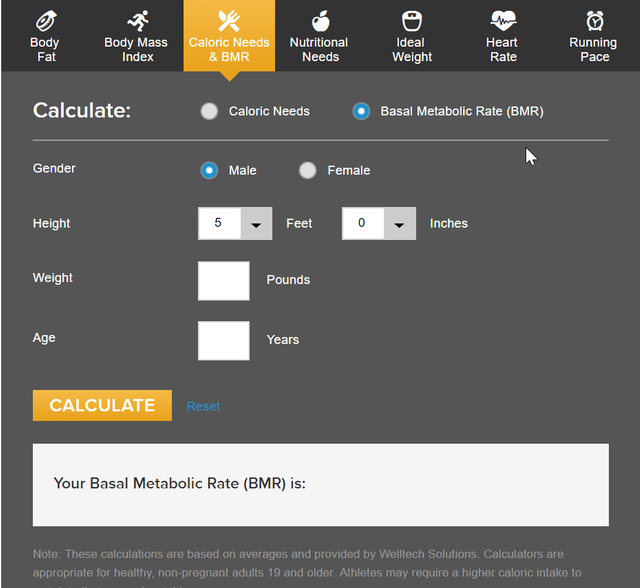
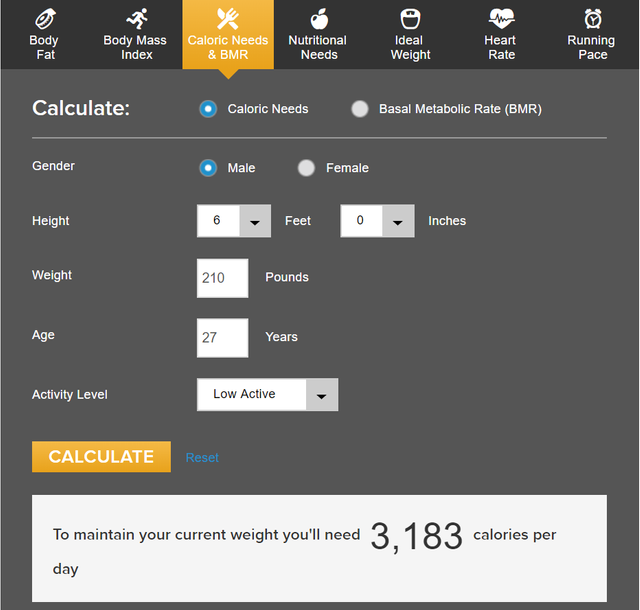
You can check out the calculator from the images by clicking here ! Feel free to use any other calculator out there (there are a lot of them).
To maintain your current weight you need a certain amount of calories that you can calculate using an online calculator. I encourage you, do it. You will need the value for the next part of the article.
If you decide to calculate them yourself you can read trough the next section, otherwise, feel free to skip it.
How to calculate the amount yourself
- Calculate your BMR
- Choose your Activity Factor
- Multiply your BMR by the appropriate Activity Factor
Does this seem overwhelming ?
It is completely okay if it does... I will guide you trough every step and give you an example which you can follow.
What is BMR ?
The Basal Metabolic Rate (BMR) is the amount of energy (calories) your body needs while resting. This accounts for about 60 to 70 percent of calories burned in a day. In general, men have a higher BMR than women.
One of the most accurate methods of estimating your basal metabolic rate is the Harris-Benedict formula:
Male: 66 + (6.3 x body weight in lbs.) + (12.9 x height in inches) - (6.8 x age in years)
Female: 655 + (4.3 x weight in lbs.) + (4.7 x height in inches) - (4.7 x age in years)
What is an Activity Factor ?
The Activity Factor (PAL) is a way to express a person's daily physical activity as a number, and is used to estimate a person's total energy expenditure.
| Lifestyle | Example | Activity Factor |
|---|---|---|
| Sedentary | Office worker getting little or no exercise | 1.40 |
| Moderately active | Construction worker or person running one hour daily | 1.70 |
| Vigorously active | Agricultural worker (non mechanized) or person swimming two hours daily | 2.00 |
| Extremely active | Competitive cyclist | >2.40 |
Let's work out trough an example of our own
Let's say i am a 29 year old male, 5 foot 9 inches, 210 pounds and i am a librarian. This is a Sedentary Job so i don't get to do a lot of phyisical activity during the day.
- Calculate your BMR - 2081 = 66 + (6.3 x 210 pounds) + (12.9 x 69 inches) - (6.8 x 29 years)
- Choose an Activity Factor - Sedentary Job 1.4
- Multiply the BMR by the Activity Factor - I need to consume 2914 (1.4 * 2081) to maintain my weight
What happens after we know our maintain calories ?
Think of your maintain calories as a boundary. If you eat more calories - you gain weight, if you eat less - you lose weight.
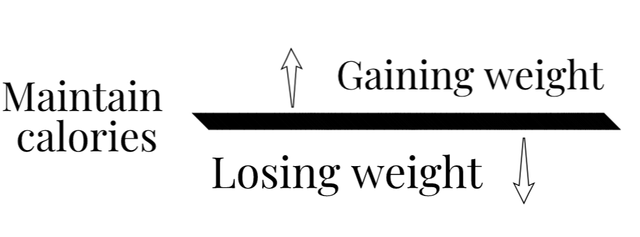
Okay, eating less, we get it. It is easy to talk about eating less than it is to actually do it in a correct and maintainable way. And by the way, eating less in this context means that you will be eating more, but healthier food.
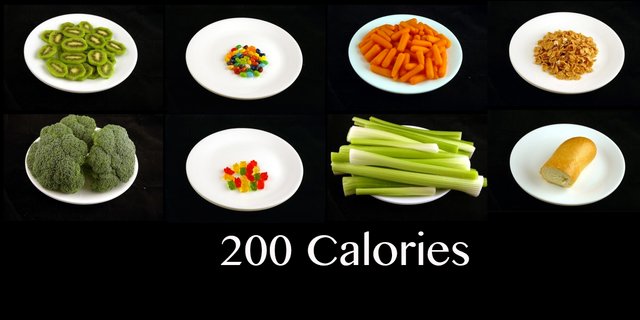
Losing weight (fat) is a result of sustaining a calorie deficit. You body requires X amount of calories to maintain weight. If your body needs 3000 calories each day to maintain, you can deprive it of 300-500 calories a day in order to lose body fat. At the same time, keep in mind that 2500-2700 calories is a lot.
Exactly how big of a calorie deficit should you aim for?
The optimal calorie deficit is large enough to stimulate steady fat loss, but not so large that you're always hungry. Avoiding a calorie deficit that is too large is even more important for people who want to retain as much muscle mass as possible and those who workout a lot. The calorie deficit "sweet spot" is around 300 to 500 calories per day.
Fitting that into our example would give us a daily calorie goal of 2914 - 500 = 2414
Okay, we get it now. Depriving your body of couple of calories a day ultimately leads to fatloss.
At what rate does this work ?
From my own personal experience, eating around 2400 calories a day helped me cut down over 20 pounds for a period of 2 months (even faster if you do not cheat at all).
There is one last step before you can start mastering the diets
What is IIFYM ?

IIFYM is the diet I have been using for over 2 years and this is the only diet I have ever made trough. It is flexible and sustainable, yet it is yielding high quality results.
It was 20th October 2016. I was over 210 pounds and I desperately needed some way to cut down. I searched extensively and fortunately, I found these fitness models who were doing IIFYM. I immediately got hooked since they were actually recording themselves of doing it and it was working.
How do you start IIFYM ?
What does flexible and non-restrictive diet means ?
IIFYM 101: Never go way above your daily calories that you calculated in the first part of the article
IIFYM 202 : You focus on only ONE goal. Consuming a fixed amount of macronutrients every single day. If I need to consume 69 grams of fat a day, I try to never go 5-6 grams below or above (below is always better than above and you can go below even more depending on your preferences)
Okay, let us fit this into our examle from above. I consume 2400 calories every day, but... How do i calculate my macronutrients from which these 2400 calories have to come ?
The easy way...
Using a tool or an application such as MyFitnessPal (which I use and highly recommend for tracking your daily calories and macros)
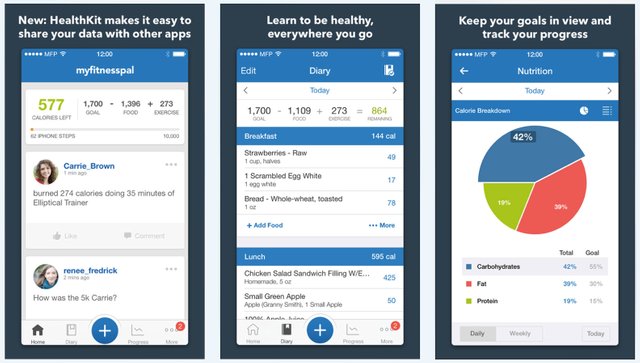
Or a web tool such as the one you can find here.
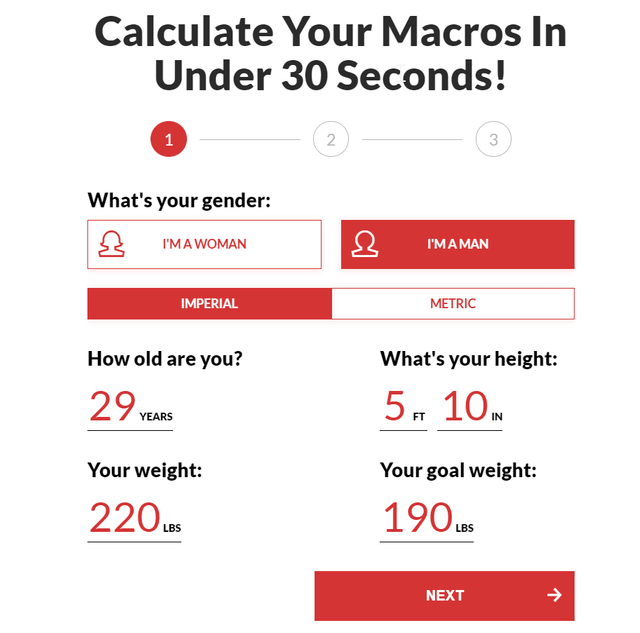
The hard way...
Doing it yourself can be harder but more rewarding in the long run since you can adjust the allocations of your macros with your preferences (e.g whether you like to eat nuts, avocado, fish - foods that are rich in fats).
I will be using the example from above.
Goal: 2400 Calories a day
Protein
Multiply your weight in lbs by 0.8 to 1.2 depending on your body fat percentage (the more athletic you look, the higher the ratio). Then multiply the amount by 4 calories and subtract them from your daily calorie intake.
I chose the ratio of 0.9 for our fictional example. We get 0.9 * 210 pounds = 189 grams of protein a day.
We subtract the calories from these 189 grams of protein from our daily intake.
1 gram of protein = 4 calories
This means that we get 189 grams * 4 = 756 calories from our protein intake each day
Remaining: 2400 - 756 = 1644 Calories
Fats
Multiply your weight in lbs by 0.3 - 0.6 depending on how much do you like to eat foods that are rich in fats (e.g nuts, fish, avocado).
I chose the ratio of 0.3 (you can always change as you go) . We get 210 pounds * 0.3 = 63 grams of fat a day.
1 gram of fat = 9 calories
This means that we get 63 grams * 9 = 567 calories from our fat intake each day
Remaining: 1644 - 567 = 1077 Calories
Carbohydrates
Divide your remaining calories by 4 and you will get the amount of carbohydrates that you need to consume every single day.
1 gram of carbs = 4 calories
This means that we get 1077 / 4 = 270 grams of carbohydrates every single day
Remaining: 0 Calories
Diet Summary
You do not go over 2400 a day and you do not go below them.
Daily Macronutrients:
Protein: 189 grams
Fats: 63 grams
Carbohydrates: 270 grams
As you progress...
As you start losing body fat, you will most probably hit plateau. What can you do about it ?
Adjust... adjust... adjust.

Always adjust your diet every 2 weeks or so since as you start losing weight your body starts requiring more deficit and less calories to maintain.
If you eat 2400 a day when you are 210-220 pounds, you will be eating 2200 when you are 190-200 pounds or so.
You hit Plateau ?
If you do not see progress at all then try cutting down a little bit more calories (maybe subtract 20 carbs from your daily intake) and stay at this level for some time. Try to figure out what works and what doesn't. It is okay if you don't see immediate results. It usually takes around 2 weeks to start seeing actual progress.
What about cheating ?
We are all humans and we ought to cheat from time to time. There is no point in feeling unhappy about what we eat and how we eat. I myself cheat every one to two weeks, yet I get results.
At some point, cheating is even beneficial. It will keep your cravings at a low level, even though the goal of IIFYM is to hit a certain amount of calories a day and your body doesn't really care where it is going to getthem from (whether it is a chocolate bar or oatmeal).
This is where your journey begins
It is time that you take a step forward and start doing the work that is required to get into shape. I encourage you to try this diet for 2 weeks to a month. I guarantee you, the results will be astonishing.
Before you go...
There is a lot more to discuss about this topic such as proper foods and meals, tips and tricks, etc.
Hit me up in the comments if you would like to see an actual example of what I eat and how i prepare my food so that I hit my daily macros. If you have any other questions, ask them below or email me.
Email: [email protected]






